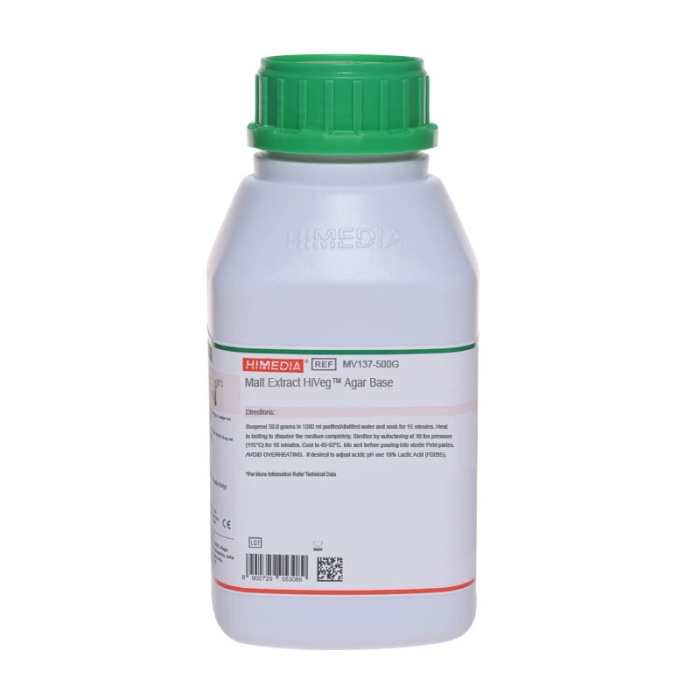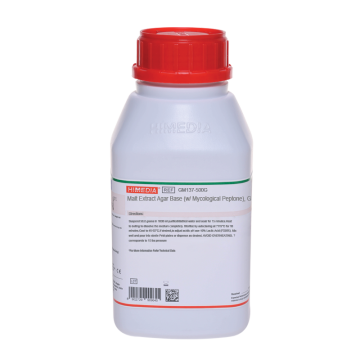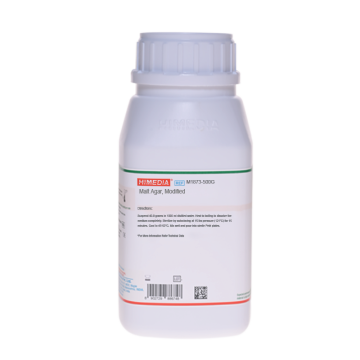 Your enquiry has been submitted
Your enquiry has been submitted
Malt Extract Agar Base (w/ Mycological Peptone)
Psychrotrophic Microorganisms#CC293D
Intended Use
Recommended for the detection, isolation and enumeration of yeasts and moulds.
Composition
| Ingredients | g/L |
|---|---|
| Malt extract | 30.000 |
| Mycological peptone | 5.000 |
| Agar | 15.000 |
| Final pH (at 25°C) | 5.4±0.2 |
Formula adjusted, standardized to suit performance parameters
Directions
Suspend 50.0 grams in 1000 ml purified/distilled water and soak for 15 minutes. Sterilize by autoclaving at 115°C(10 lbs pressure) for 10 minutes. Mix well before dispensing. Avoid overheating. If desired, to adjust acidic pH use 10% Lactic Acid solution (FD095).
Principle And Interpretation
The laboratory diagnosis of fungal infection relies largely on direct as opposed to indirect methods. The use of malt and malt extracts for the propagation of yeasts and moulds is quite common. Reddish (1) described a culture medium prepared from malt extract that was a satisfactory substitute for wort. Malt Extract Medium is similar to the formula of Galloway and Burgess (2) used for the detection, isolation and enumeration of yeasts and moulds.
Malt extract provides an acidic environment and nutrients favorable for growth and metabolism of yeasts and moulds. Mycological peptone rapidly gives a luxuriant growth with typical morphology and pigmentation. For mycological count, it is advisable to adjust the reaction of medium more acidic with addition of 10% lactic acid solution. Antibiotics may be added as sterile solutions to the molten medium immediately before pouring into sterile Petri plates (3) in order to suppress bacterial growth.
Type of specimen
Clinical samples: skin scrapings.
Specimen Collection and Handling
For clinical samples follow appropriate techniques for handling specimens as per established guidelines (4,5).
After use, contaminated materials must be sterilized by autoclaving before discarding.
Warning and Precautions
In Vitro diagnostic use only. Read the label before opening the container. Wear protective gloves/protective clothing/ eye protection/face protection. Follow good microbiological lab practices while handling specimens and culture. Standard precautions as per established guidelines should be followed while handling clinical specimens. Safety guidelines may be referred in individual safety data sheets.
Limitations
- It is a general purpose medium which supports growth of bacterial and fungal cultures.
- Further biochemical tests must be carried out for further identification
Performance and Evaluation
Performance of the medium is expected when used as per the direction on the label within the expiry period when stored at recommended temperature.
Quality Control
Appearance: Cream to beige homogeneous free flowing powder
Gelling: Firm, comparable with 1.5% Agar gel
Colour and Clarity of prepared medium
Amber coloured clear to slightly opalescent gel forms in Petri plates
Reaction
Reaction of 5.0% w/v aqueous solution at 25°C. pH: 5.4±0.2
pH: 5.20-5.60
Cultural Response
Cultural characteristics observed after an incubation at 25-30°C for 48-72 hours.
| Organism | Inoculum (CFU) | Growth | Recovery |
|---|---|---|---|
| # Aspergillus brasiliensis ATCC 16404 (00053*) | 50-100 | luxuriant | - |
| Candida albicans ATCC 10231 (00054*) | 50-100 | luxuriant | >=70% |
| Saccharomyces cerevisiae ATCC 9763 (00058*) | 50-100 | luxuriant | >=70% |
| Penicillium chrysogenum ATCC 9179 | 50-100 | luxuriant | - |
| ##Trichophyton interdigitale ATCC 9533 | 50-100 | luxuriant | - |
Key: *Corresponding WDCM numbers.
# Formerly known as Aspergillus niger
##Formerly known as Trichophyton mentagrophytes
Storage and Shelf Life
Store between 10- 30°C in a tightly closed container and the prepared medium at 20-30°C. Use before expiry date on the label. On opening, product should be properly stored dry, after tightly capping the bottle in order to prevent lump formation due to the hygroscopic nature of the product. Improper storage of the product may lead to lump formation. Store in dry ventilated area protected from extremes of temperature and sources of ignition Seal the container tightly after use. Use before expiry date on the label. Product performance is best if used within stated expiry period.
Disposal
User must ensure safe disposal by autoclaving and/or incineration of used or unusable preparations of this product. Follow established laboratory procedures in disposing of infectious materials and material that comes into contact with clinical sample must be decontaminated and disposed of in accordance with current laboratory techniques (4,5).
Reference
- Reddish A., 1919, Abstr. Bacteriol., 3:6.
- FDA Bacteriological Analytical Manual, 2005, 18th Ed., AOAC, Washington, DC.
- Gallowey L. D. and Burgess R., 1952, Applied Mycology and Bacteriology, 3rd Ed., Leonard Hill, London, pg. 54 and 57.
- Isenberg, H.D. Clinical Microbiology Procedures Handbook. 2nd Edition.
- Jorgensen, J.H., Pfaller, M.A., Carroll, K.C., Funke, G., Landry, M.L., Richter, S.S and Warnock., D.W. (2015) Manual of Clinical Microbiology, 11th Edition. Vol. 1.
| Product Name | Malt Extract Agar Base (w/ Mycological Peptone) |
|---|---|
| SKU | M137 |
| Product Type | Regular |
| Physical Form | Powder |
| Origin | Animal |
| Packaging type | HDPE |
| References | 1. Reddish A., 1919, Abstr. Bacteriol., 3:6. 2.FDA Bacteriological Analytical Manual, 2005, 18th Ed., AOAC, Washington, DC. 3.Gallowey L. D. and Burgess R., 1952, Applied Mycology and Bacteriology, 3rd Ed., Leonard Hill, London, pg. 54 and 57. 4.Isenberg, H.D. Clinical Microbiology Procedures Handbook. 2nd Edition. 5.Jorgensen,J.H., Pfaller , M.A., Carroll, K.C., Funke, G., Landry, M.L., Richter, S.S and Warnock., D.W. (2015)Manual of Clinical Microbiology, 11th Edition. Vol. 1. |
| Customized Product Available | No |















